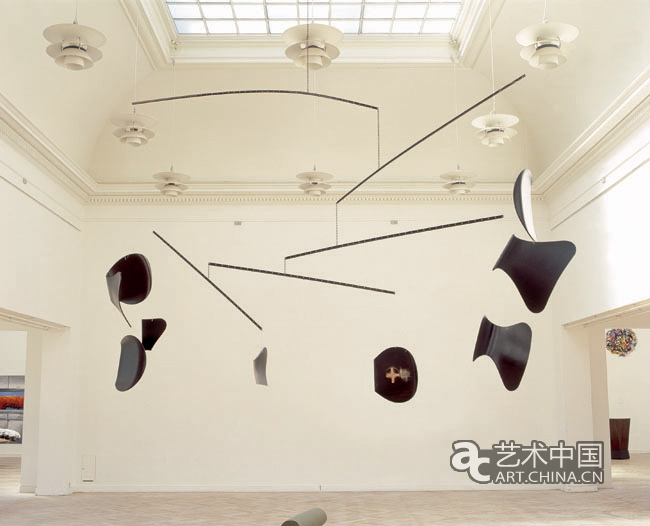馬丁博伊斯 - 活動裝置(與你在一起就像新的過去) |
| 藝術中國 | 時間: 2010-01-29 18:36:36 | 文章來源: 藝術中國 |
|
馬丁博伊斯 -《活動裝置(與你在一起就像新的過去)》 Martin Boyce Mobile (Being With You Is Like The New Past) 2002 Mixed painted steel, chain, wire, altered Jacobsen 3107 chairs Dimensions variable 馬丁 .博伊斯 活動裝置(與你在一起就像新的過去),2002 混合涂層鋼板,鏈條槽,線材,雅各布森3107椅子 可變尺寸
馬丁?博伊斯的作品里總是有鬼魂出現,《活動裝置(和你在一起就像新的過去)(Mobile (Being with you is like the new past))》也不例外。第一眼看去,作品中懸掛的形狀奇異的深色陰影,像神秘的鬼魂一樣漂浮在空氣中,既優雅又詭異。與1931年發明了現代流動藝術的亞歷山大?考爾德的作品相比,博伊斯作品的結構更具陰暗不祥的氣息。但是,博伊斯雕塑中漂移著的不是卡爾德鐘愛的典型抽象形狀,而是丹麥建筑師和設計師阿爾尼?雅克布森設計的椅子的零件。這些椅子零件源自于雅克布森于1955年設計的《3107椅子》,也叫“系列7”椅子,是雅克布森最知名的設計作品。 從這一時期起,博伊斯的多數作品中就都表現了他對現代主義設計和建筑的標志符號的迷戀,同時還有包含在留存物品中的持續氣氛和思想意識。除雅克布森之外,設計師查爾斯和蕾?伊默斯對這一時期的博伊斯也產生了重要影響。他的這一系列作品蘊含虛幻鬼魂般的氣質,經常被歸入大氣環境類,可以用“不死的夢想”來描述。他2003年創作的通風網柵雕塑就用這個詞組命名為《幻肢(不死的夢想)(Phantom Limb (Undead Dreams))》 ,這件同時期的雕塑作品以伊默斯的“夾板雕塑(Splint Sculpture)”(1942)為基礎,其原型在博伊斯的作品中變形之后以類似卡通幻象的形式再現。 在某種程度上說,這里比較危險的一個概念就是從20世紀中期開始在美國制造業中漸漸普遍的“內在陳舊性”概念,即經濟的迅速發展是以人們愿意丟棄舊物為支柱。尤見于這一時期的加利福尼亞現代主義設計夢想,其基礎就是一個對戰后經濟的烏托邦式的解決方案:能夠改變普通家庭生活方式的可用物品。然而,隨著時間的推移,這些“經典”設計卻成為了專屬富人和受過高等教育人群的奢華商品。博伊斯的作品《移動》對民主設計和“功能決定形式”的原則加以諷刺嘲笑,因為作品中的椅子和靠背都掛在無法觸及的地方,根本不能使用。博伊斯對這些設計“符號”的重構暗喻著現代主義本身從最初開始就包含內在性陳舊。正如威爾?布拉德利所說:現在走近這些50年之久的鬼魂揭示了現代主義的“情感聯系”——不僅僅在于思想的聯系,也在于“接受某些形式策略可以實用性地表現那些思想。現在那種接受已經消失了。很少有人會傻到認為美麗的鮮花或睿智的設計能填補我們社會和政治結構上的鴻溝空洞。” 然而,如果可以呢?這些椅子、這些設計中還保留著什么樣未曾開發的烏托邦式的希望呢?是不是能夠從中看出另一個未來或現在呢?博伊斯流動設計作品的副標題“和你在一起就像新的過去”暗示著作品與時間的獨特關系。與某人“在一起”指現在,至少是相對的現在,而使用“新的”過去又放寬了作品的瞬時性。博伊斯在談到自己的作品和伊默斯的雕塑時說,它們是創造了原型的“脫軌的”形式,這些物品本來是會在平行的道路上存在于現在。我們很難說這些重構后的物品究竟是來自更好的還是更糟 的時代,但是,正如博伊斯所說,它們都充滿了截然不同的、波動變化的潛力。它們在地面上迂回盤旋,保持一種懸而未決的狀態,幽靈鬼魂似的在這里等待著其他想象中的未來。 L.M.F. Ghosts are ever present in the work of Martin Boyce, and Mobile (Being with you is like the new past) is no exception. At first glance, what appear to be oddly formless, dark shapes hang from a mobile, floating in the air like unlikely spirits, with a mixture of grace and awkwardness. The structure of the work suggests a more ominous rendering of the mobiles of Alexander Calder, who invented the modern mobile in 1931. Suspended in Boyce’s sculpture, however, are not the distinctly abstract shapes of which Calder was fond, but parts of chairs designed by the Danish architect and designer Arne Jacobsen. The parts come from the 3107 Chair, designed in 1955, also known as the ‘series 7’ chair, perhaps the design for which Jacobsen is best known. As in much of Boyce’s work from this period, there is a fascination with icons of Modernist design and architecture, and with the continuing atmospheres and ideologies that might be contained within the remaining objects. As well as Jacobsen, the designers Charles and Ray Eames play an important role for Boyce at this time. The ghostly atmosphere of this series of works, often grouped together in atmospheric environments, might be encapsulated by the phrase ‘undead dreams’, which can be read on the artist’s sculptures of ventilation grills. Phantom Limb (Undead Dreams) (2003) , a contemporaneous work, is a sculpture based on an Eames ‘Splint Sculpture’ (1942), which reappears in Boyce’s work, altered, and resembling a cartoon phantom. What is, to some extent, at stake here is the idea of built-in obsolescence that was becoming common in American manufacturing in the mid 20th century, with a burgeoning economy supported by a willingness to discard objects. The dreams for Modernist design, particularly seen in California during this period, were based in utopian solutions for a post-war economy: usable objects that might change the way the average family lived. Ultimately, however, over time these ‘classic’ pieces of design became luxury commodities for the rich and educated. In Mobile, the principles of democratic design and ‘form follows function’ are ridiculed, as the chairs’ seats and backs dangle out of reach, impossible to use. Boyce’s reframing of these design ‘icons’ speculates that Modernism itself also contained built-in obsolescence from the start. Approaching these 50-year-old ghosts now, as Will Bradley has commented, reveals the ‘emotional bond’ of Modernism – not only in relation to ideas, but in ‘the acceptance that certain formal strategies could usefully represent those ideas. That acceptance has gone. Few people, now, would be fooled into thinking that pretty flowers or even thoughtful design could bridge the gaping holes in our social and political structures.’ And, yet. What if? What utopian hope remains in these chairs, these designs, untapped? Is another, alternative future or present discernible? The subtitle of Boyce’s mobile, Being with you is like the new past, hints at the work’s peculiar relationship to time. ‘Being with’ someone connotes the present, or at least presentness, but the invocation of a past that is ‘new’ loosens its temporality. Boyce has spoken of his work with Eames OW MANYsculptures as creating ‘derailed’ versions of the original – objects that might have ended up in the present via a parallel route. Whether these objects come from a time that is better or worse is hard to say. However, as rendered by Boyce, they are charged with different, fluctuating potentials. They hover, above the ground, in a kind of limbo, a spectral waiting area for other imagined futures. L.M.F. |
| 注:凡注明 “藝術中國” 字樣的視頻、圖片或文字內容均屬于本網站專稿,如需轉載圖片請保留 “藝術中國” 水印,轉載文字內容請注明來源藝術中國,否則本網站將依據《信息網絡傳播權保護條例》維護網絡知識產權。 |
